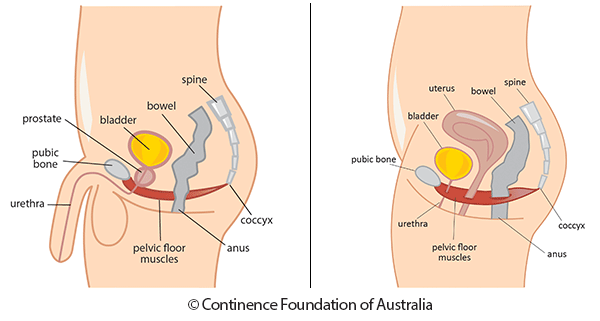Pelvic Floor exercises for Men
The pelvic floor is a complex layer of muscles and ligaments which stretches like a hammock from the pubic bone at the front of your pelvis to the coccyx at the bottom your spine.
A man’s pelvic floor supports his bladder and bowel. The urethra (waterpipe) and the rectum (back passage) pass through the pelvic floor muscles.
The pelvic floor has several functions:
- it supports your pelvic and abdominal organs, especially when you are standing or straining;
- it helps your urethra stay closed when you cough, sneeze or strain; and
- it controls leakage of wind or motions from your lower bowel.
The pelvic floor muscles can be weakened by:
– operations on your prostate gland;
– operations on other organs within the pelvis (e.g. the bowel);
-damage to the nerves of your pelvic floor muscles (by disease, injury, surgery or radiotherapy);
– repeated straining to empty your bowels, usually due to constipation;
-a chronic cough such as a smoker’s cough, chronic bronchitis or asthma;
– being overweight
-lack of general fitness; and ageing.
Pelvic floor exercises are an important part of preparation before surgery for removal of your prostate for cancer (radical prostatectomy). They ensure that the pelvic floor muscles are in good condition and can help reduce urine leakage after the operation.
How do I contract the pelvic floor muscles?
The first thing you need to do is to identify the muscles to exercise. You can do this by sitting or lying comfortably with the muscles of your thighs, buttock and abdomen relaxed.
Step 1
Tighten the ring of muscle around the back passage as if you are trying to control diarrhoea or wind. Relax the muscle again. Practice this movement several times until you are sure you are exercising the correct muscles. Try not to squeeze your buttocks, thighs or abdominal (tummy) muscles.
Step 2
Imagine you are trying to pass urine, stop the flow in mid-stream and then re-start it. If your technique is correct, you will feel the base of your penis move upwards slightly towards your tummy. You can check this “for real” while passing urine, but no more than once a week, in case it interferes with normal bladder emptying
How do I do pelvic floor exercises?
Learning how to do these exercises can take a little time but, with practice, you should be able to learn the technique:
- tighten and draw in the muscles around the anus (back passage) and the urethra (water pipe) all at once. Lift them up inside you and hold this position as you count to five. Release the muscles slowly and relax for a few seconds
- repeat the contraction and relax again. Once you find it easy to hold the contraction for a count of five, try to hold it for longer (up to ten seconds)
- repeat this for a maximum of eight to ten squeezes. Try to make each contraction strong, slow and controlled
- do the same thing again but, this time, using ten short, fast contractions, pulling up rapidly and immediately letting go
- repeat this whole exercise routine at least four to five times every day.
You can do it in a variety of positions – lying, sitting, standing and walking
- try to avoid holding your breath, pushing down (instead of squeezing) and tightening your abdominal muscles, buttocks or thighs
- the exercises can be performed standing, sitting or lying down but you may find it easier at first to do them sitting down .
You should do these exercises regularly, giving each set your full attention.
Find at least five regular times during the day to do them e.g. after going to the toilet, when having a drink, when lying in bed.
Tightening the pelvic floor before you cough, lift anything heavy or get up from a chair will also help. You will probably not notice an improvement for several weeks. It may take a few months before you get maximum benefit.
Once you have recovered control over your bowel and bladder, continue doing the exercises twice a day for life, to keep the pelvic floor muscles strong.
Other things to do include:
- avoid lifting heavy weights
- avoid constipation and straining on the toilet
- seek medical advice for hay fever, asthma or bronchitis to reduce sneezing and coughing
- keep your weight within the correct range for your height and age
- other methods which have been shown to help some men include biofeedback and electrical stimulation.
If you would like to explore other methods or you are not sure whether you are performing the exercises correctly, ask your urologist or specialist nurse. They will be able to give you more advice or put you in touch with a continence advisor or physiotherapist.

